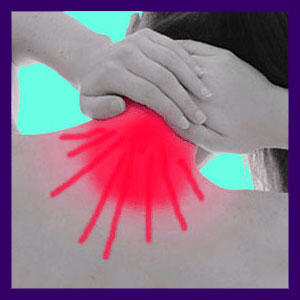
Acute neck pain can be a severe and physically-limiting condition which typically comes on fast and without mercy. The symptoms associated with serious cervical pain can be terrifying, since the specter of nerve damage or paralysis is often on a patient’s mind. Injury and degenerative processes are the 2 most common sources of diagnosed neck pain. However, there are other sources which may be responsible for symptoms including hormonal issues, glandular concerns, disease processes and mindbody disorders. The anatomy of the neck is extremely complex and features many different types of tissues in a small area. This fact further confounds proper diagnostic efforts for many symptomatic syndromes.
This discussion helps victims of acute neck pain to find relief from their suffering.
Acute Neck Pain Causes
Severe pain in the neck can also affect the upper back, head, face, shoulders and arms. Cervical injuries can affect a variety of possible structures, including soft tissues and vertebral bones. The most common types of injury affect the muscles of the neck and upper back.
Whiplash is a good example of cervical muscular pain. This scenario can make the region very sore, but is usually not overly serious. Most cases of muscular neck pain will resolve with little or no medical treatment.
Herniated discs can be problematic and may cause severe pain which might last for some time in rare cases. Medical intervention might be required for serious disc concerns. Damage to the actual vertebrae or spinal cord can be a grave matter and must be handled by experts in emergency medicine.
Degenerative processes are often blamed for severe neck pain, but are rarely the actual cause. Far too many people demonstrate identical degeneration of the cervical structures without suffering from any symptoms. While degeneration can be a contributor to neck pain, it is not usually the main or only causation, particularly when the extent of deterioration is within the normal range.
Acute Neck Pain Treatment
It is important to begin all back pain treatment programs with the most conservative measures possible. Some treatments have potentially hazardous side effects and others might permanently reduce the patient’s functionality.
Do not rush into any type of neck surgery, or get involved with the long-term use of powerful pain management drugs, unless these modalities are your only options. Make sure to understand the risks of possible treatments 100% before agreeing to become a human test subject.
Successful resolution of pain relies on a correct diagnosis. If severe trauma has caused an obvious injury, then appropriate treatment will also be obvious. Pain caused by a less verifiable source, such as possible degenerative changes, is often difficult to treat effectively.
Many of these back pain scapegoat conditions are blamed for symptoms that are actually due to another structural issue or even a mindbody process. If a cure has eluded you for a long time and symptoms remain acute, then there is a definite chance that the working diagnostic theory may be wrong. This is far more common an occurrence than most patients know.
Acute Pain in the Neck Realities
Whatever the reason for your acute pain, it is crucial to have faith in your treatments. In order to truly recover, you must heal physically and accept the recovery psychologically. If you feel you have suffered permanent damage, there is a good chance that you will develop chronic pain due to the nocebo effect of the diagnosis. Make sure to keep a positive mental state and move past the injury or pain, back towards a normal and limitation-free lifestyle.
The mind and the body play equally important roles in the development and resolution of pain. Remember this advice and you will hopefully be on the road to recovery in no time.




